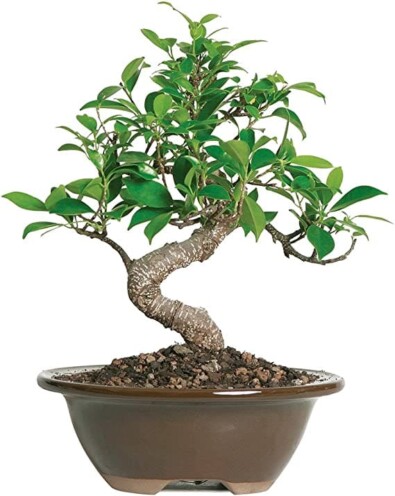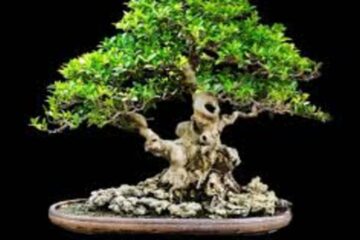Are you planning to grow bonsai trees? Bonsai tree growing is a very peaceful form of hobby. It is gratifying to see your determination and care grow into a tree. And they enhance the aesthetic beauty of your home at the same time.
Now, many people are asking, “How old are bonsai tress?” The reason is quite obvious that many people will not want to spend their time watching a tree die days later. So let’s find out the answer to that question below.
Stay with me until the end as I delve a little deeper into the lifespan of a bonsai tree.
How old are bonsai trees?
Content Overview
Well, any tree can be a bonsai tree and it can live as long as a regular sized tree. So, there is no set number for how old are bonsai tress. Some trees can die within months of growing and some trees can live up to 1000 years.
There are many popular trees that have lived for hundreds and thousands of years. In some cases, bonsai trees can live longer than a normal size bonsai tree. What is the reason for this? Well, there are many factors behind the lifespan of a bonsai tree.
Now, the question is, how do you tell apart which one will live longer? It is very common. You go through some of the factors underlying the lifespan of a bonsai tree and make the right choice. If you make the right choices and do the right things, you can end up with a tree that will at least live longer than you live to see it.
How long does a bonsai tree grow from seed?
How long it takes for your bonsai plant to grow from seed depends on the variety of plant and when and how you planted it. Many people who plant bonsai trees never see them sprout. It takes a lot of careful care and, quite honestly, a bit of luck.
With that being said, if the odds are in your favor, if you grow bonsai indoors, you can expect to see a shoot begin to sprout about four weeks after planting. If you try to grow it outside, the seeds won’t germinate until early spring.
If they don’t germinate and you grow your seeds outside, you probably planted them too late. It is also doubtful that if you plant a seed, a seed will germinate. For best results, plant several seeds to increase the chance that one of them will germinate. Once the seeds have germinated, you probably won’t be able to shape your tree for at least 3 to 5 years.
Read More :Ultimate Guides How To Grow A Bonsai Tree from Seed?
What is the lifespan of bonsai trees?
Just because trees are small doesn’t mean they won’t live long. Bonsai trees can live anywhere from a few months to hundreds of years. The most important factor that determines how long a bonsai tree lives is how well you take care of it.
Bonsai trees are just miniature versions of regular trees. Therefore, they have the same chance of survival as other plants. However, if they are grown indoors, they are less susceptible to damage from disease and other natural elements. Bonsai trees are also subject to more care, which can extend their lifespan.
While the amount of care they receive is the biggest factor in how long bonsai plants live, there are other factors as well. Let’s look at each of these factors in more detail.
Read More : How To Take Care of a bonsai tree
Tree Species
It is an integral part of a tree that determines its lifespan. When you choose an appropriate species, you end up with a tree that can live a long time. I’ll go through the different long-lived species in a moment.
To give you some reference, there is a famous bonsai tree, a ficus bonsai, and it is known to have lived for over 1000 years. So, in summary, among other types of bonsai plants, the Ficus species is famous for its long lifespan.
Environment and Conditions
Whether it’s a regular tree or a bonsai tree, the environment can affect their growth and lifespan. With perfect conditions, a bonsai tree can easily live for a long time. The thing about bonsai plants is that you can create the ideal environment for your plant without relying on nature.
This is where your work begins to extend the life and growth of your plant. Depending on the species, you need to create conditions that support and enhance your plant’s growth.
Unlike regular plants, you can’t expect nature to do the work for you with bonsai trees. This is why watching a bonsai plant grow is so rewarding because you have to work hard to get it to grow properly.
Amount of care
Bonsai trees are by no means low maintenance. They are shaped and designed to keep small. Doing so means they require almost constant care to keep in shape and live long and healthy lives.You check how to shape a bonsai tree.
Sunlight and Water
Remember that bonsai trees are not a specific species of tree. Instead, they are a miniature version of a variety of plants. Therefore, they need the same amount of sunlight and frequency of watering that larger plants of the same type need. Knowing the species of your bonsai tree is the first step in caring for it.
Once you know the species, you can provide the right amount of sunlight and water for your plant. You don’t have to water your bonsai plant every day, but sticking to a watering schedule can help ensure your plant stays hydrated. When the plant dries up, it will begin to die.
Read More :How often Do You Water a bonsai tree?Ultimate Beginners Tips
Pests and Diseases
Although bonsai plants are just as susceptible to pests and diseases indoors as outdoors, they can still be affected. If you have other plants in your home, any pests or diseases they carry can affect your bonsai. Monitor all your plants closely for signs of pests or diseases and treat them as soon as possible.
Pets and Children
If you have pets and children, they can also affect the health of your bonsai tree. Usually, they don’t cause problems on purpose, but it’s a good idea to keep the plant away from them to avoid any accidents.
For example, your pet may eat or relieve itself on your plant. Curious children also want to touch and play with plants. These things can affect how long your tree lives if you’re not careful.
Related : Are bonsai trees poisonous to cats? Know How to Save them?
Pruning and Repotting
Finally, repotting your bonsai tree is essential. Yes, they will stay small if you keep them trimmed and in shape, but they will still grow in size, especially in their early years of growth. Your bonsai can outgrow its container which can interfere with future growth and how it receives nutrients. If your plant isn’t in the right size container, it won’t thrive and may eventually die.
Related :How to Repot a Bonsai for Beginners Complete Solutions
Little Luck
Yes, you heard right. Luck is also a factor in increasing the lifespan of bonsai plants. how is that Many bonsai trees can accidentally catch some disease and the final destination is the death of the tree. Sometimes there is nothing you can do about it.
And that’s where luck comes in. You can hope that you are lucky enough to have a tree that does not develop any serious diseases. But lack of care can cause some diseases. As I said, proper care beforehand is an important factor in extending the life of any bonsai plant. So, you cannot ignore it at all.
That way you can end up with a tree that will live long into the future. First, you choose a species that is known to live a long time. Then you create the perfect conditions for it to grow and live to the best of your ability. Then, you go through proper plant care. And if you’re lucky, you’ll definitely end up with a tree that can live on long after you’re gone.
Which bonsai tress live the longest?
Now, among the above factors, the most difficult is to select a suitable species. If you don’t know the bonsai tree species, finding the right one can be quite difficult. That’s why I’m going to help you with some familiar and popular choices. They are generally known to be long lived-
1.Ficus Bonsai Trees
As I mentioned earlier, a ficus is the oldest surviving bonsai tree. This is just proof that with the right care and conditions, you can even grow a ficus to live for 1000 years. Although the number is not specified for this tree, you can still get an idea of the potential of this species.
2. Pine Bonsai Tress
Pine is another bonsai species that has a name for itself when it comes to a long lifespan. There is a popular Japanese white pine that has been known to live for over 400 years. Apart from its longevity, this plant looks extremely beautiful as a bonsai because of its full appearance.
3. Cypress Bonsai Tress
This is another very attractive bonsai tree that can live for a long time. An example of this species survived for over 200 years in a single container. However, if you are not prepared to work on your tree and care for it as life, the cypress is not the tree for you. These plants require a lot of care and effort to survive for a long time.
Well, apart from these, you can also find others like azalea, maple, cherry, juniper, etc., which have a long lifespan. But none of that really matters if you don’t take good care of them. It is an essential part of growing bonsai plants that can live longer.
Is it difficult to keep bonsai trees alive?
Keeping bonsai plants alive isn’t that difficult if you know what you’re doing and follow proper care recommendations. Before attempting to grow a bonsai tree, make sure you research the different species and find one that you can reasonably care for.
How can tell you the age of bonsai trees?
You can determine the age of most trees by cutting them down and counting the number of rings on their trunks. You don’t want to do this to a bonsai plant because it will kill the plant you worked so hard to take care of.
Fortunately, there is another way to tell how old your bonsai tree is without cutting it down. However, you need to know which species of bonsai tree to do this for. If you know the species, follow these steps.
- Take a measuring tape and run it around your bonsai tree at a height of 1.5 inches from the ground. It measures your circumference.
- Divide the circumference measurement by 3.14 (pi). This will give you the diameter measurement of the tree.
- Find the growth factor for the plant species you have by searching online. Just Google the species you follow by “growth factor” and you’ll get a number value. Multiply the diameter by the growth factor to determine the age of your tree.
As long as you know the tree species, you can use a tree age calculator to find out the age of your tree.
How old is the world’s oldest bonsai tree?
The world’s oldest bonsai tree can be found at the Crespi Bonsai Museum in Milan, Italy. This is a ficus bonsai that is over 1,000 years old and about 10 feet tall. It is planted in the world’s largest bonsai pot.
Another notable bonsai is about 400 years old. This is a Japanese white pine bonsai near Hiroshima, Japan, when the atomic bomb was dropped on Hiroshima during World War II. Despite the widespread devastation around it, the tree survived and is now in the United States National Arboretum.
Can you extend the life of a bonsai tree?
Yes, you can. All you do is take proper care of the tree and you can easily extend its life. Regardless of the species or any other factor, with proper care, you will affect the lifespan of any bonsai tree. The real question here is, how do you do that?
There are several things you need to follow to take care of a bonsai tree. The first thing is to know the tree. What do I mean by that? Knowing the plant simply means you need to learn the perfect conditions and environment for your plant.
Some plants live well outdoors, and some grow well indoors. You must know which one you have and act accordingly. Next is watering the bonsai tree in the right way. You should always make sure that the moisture content of the bonsai soil is maintained properly. You may need to water your plants more in the summer due to excess heat and dryness.
Another care is the measuring pot. This is important in the growth of your bonsai tree. You need to get the right fertilizer for your plants and create the perfect soil mix. Or you can go for a potting mix to ensure your plant grows properly.
Finally, pruning is an integral part of extending the lifespan of a bonsai tree. Pruning your bonsai tree properly keeps it healthy, which increases your tree’s longevity. With proper pruning, you will see a response in your plant’s growth and appearance.
Doing all these things perfectly will lead you to a much larger living bonsai tree. You never know. You may end up with someone who lives for 100 years.
Final Verdict
All in all, how long a bonsai tree will live will come down to the person growing them. A regular bonsai can easily live 100 years if they do a great job of maintaining proper condition and take good care of it. And with the right species, the number can go much higher than that. So, the bottom line is that taking good care of a bonsai will live longer than it should.






